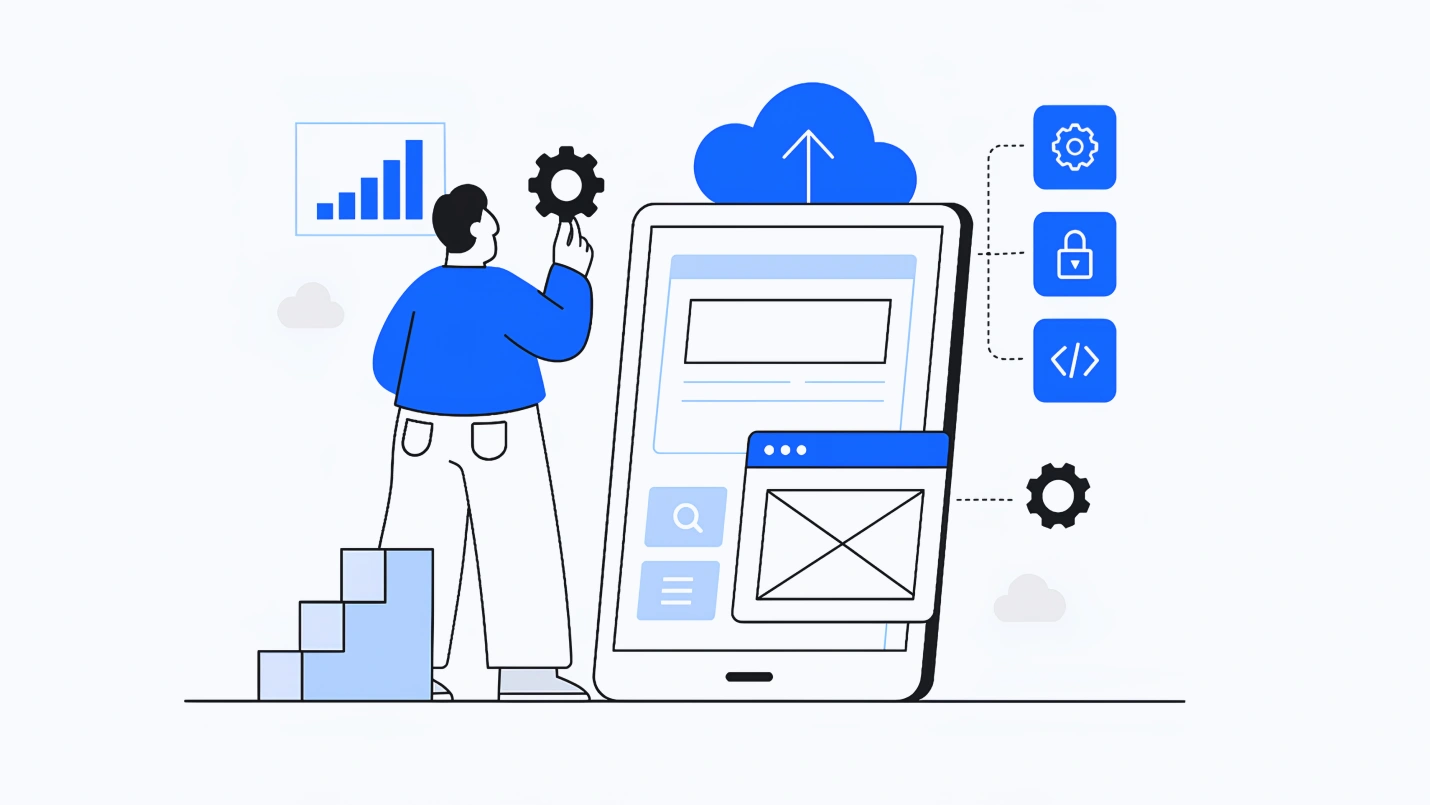With shrinking attention span, today, users have zero tolerance for latency or downtime, even under the heaviest workloads. Failure to deliver a lightning-fast and seamless experience results in app abandonment for more secure and scalable web applications that offer user experience better than yours.
On April 28, at 4:00 PM IST, the people of India faced a similar experience when the COVID-19 vaccine registration’s multiple portals – CoWin app, CoWin website, Aarogya Setu App, and Umang App – malfunctioned and displayed the error “CoWin server is facing issues. Please try later” as millions of people rushed to register.
“More than 1 crore people are trying to register that is why the server is facing issues.” – RS Sharma, CEO, National Health Authority
The users (18-44 years of age) could not register for the COVID vaccination on their web page or app and took the issue to social media in no time. Building scalable web apps means the app can handle a huge data stream without breaking down.

As of now, the app and the website are loading fine, and users can register themselves on the portal. Reacting to the issue that emerged due to the heavy traffic, Aarogya Setu handle tweeted:
Cowin Portal is working. There was a minor glitch at 4 PM that was fixed. 18 plus can register. pic.twitter.com/c94fpoURcT
— Aarogya Setu (@SetuAarogya) April 28, 2021
How to Avoid Such Web/Mobile App Glitches?
The most successful moments – when your mobile/web application sees rapid growth – also have the potential to become your worst day; however, this need not be the case if you plan, test, and optimize continuously for scale, uptime, and unexpected growth.
Scaling isn’t just about handling a huge spike in traffic; it is also about ensuring availability and managing risk. In the following section, we discuss some key techniques for building cost-effective applications that can handle huge quantities of traffic and demand without affecting the quality that users expect.
1. Microservices Architecture
When building scalable web apps, decentralized architecture plays a vital role. Modern web application development heavily relies on microservices. The microservice architecture separates an application into loosely coupled components, decentralized systems, and lightweight protocols.
Contrary to monolithic architecture, microservices help develop, test, sustain, and upgrade web services as separate modules without affecting the entire app or the workflow.

i) Loose Coupling
Loose coupling in microservices implies that updating a particular service won’t affect the other services or the software application’s overall functionality. However, the two services will be able to contact each other through API calls.
We can say that the microservice architecture converts each of the features or functionality of the application into an independently testable, deployable, and maintainable service.
ii) Improved Scalability
The microservices architecture cuts down the headaches associated with the source code’s total rewrites when an issue arises. Building microservices helps put away the perils of days and hours of restructuring the codes by letting you divide one whole into several smaller modules.
iii) Continuous Delivery
With microservices, the development and the Agile testing team do not have to scroll endlessly through the tens of thousands of KLOCs to identify bugs or modify existing code to add new functionalities.
When divided into smaller segmented services, the large chunk of the application makes it convenient to handle the tasks mentioned above. This way, the microservices architecture facilitates the continuous delivery of software, i.e., managing the iteration in Agile becomes easy.
Thus, when the work gets restricted to smaller modules — the speed of execution increases, and so does the effort to modify or expand a particular service.
iv) Improved Fault Isolation
Let’s say, there is a memory leak in one of the services of the distributed microservices architecture. This would mean that only the affected service will experience downtime, and the fault will be isolated from the rest of the application.
Thus, fault isolation ensures that the other part of the application continues to offer seamless and uninterrupted service when one of the microservice breaks down.
2. Load-balance at Each Tier
The main purpose of load balancing is to distribute any amount of traffic among different groups of resources in order to prevent a server overload. Traffic distribution ensures that individual resources don’t become overloaded while others sit idle.
Most load balancers also offer health-checking features that ensure that the traffic is not routed to unavailable resources.
Load balancers for web application servers are usually placed between the backend servers and the firewall. They distribute client requests to available servers, thereby letting you handle high traffic conditions with zero downtime.

3. Load Testing
Your application may perform completely differently for one user (functional testing) compared to many (load testing).
Testing a website or an app under a load helps you simulate how it will perform when thousands or millions of users come to your app/website in a real-time scenario.
KPIs like error time, response time, and memory leakage might be best to evaluate when it comes to functional testing; however, when scaling to millions of users, it becomes important to understand and analyze when and where your application breaks down, fix those bugs, and avoid upset users.
Feed your application with different sports of load when you are performing a load test. For example, test maintaining a super-heavy load over time, test for sudden spikes, and test gradually increasing the load to a forecasted real-life volume.
Passing an application through a thorough load test reduces the chances of an application crashing when it meets the sudden spike in traffic.
How Net Solutions helped Euro Car Parts to Build, Maintain, and Optimize their Website?
Euro Car Parts (ECP), the UK’s largest car parts supplier, was founded in the year 1978. It has grown from a lone motor parts shop to over 200 outlets within a span of three decades. ECP turned to Net Solutions to build and maintain a multi-channel eCommerce solution as well as a content management system to organize its product catalogs.
Throughout the long-term engagement, the Net Solutions team continually tested the platform for performance bottlenecks, using their findings to optimize the back-end, improving the speed and reliability of the many websites powered by the platform.
As the website became more popular, the number of visitors increased, so Net Solutions took steps to ensure high loads would not slow down the site for visitors or, even worse, cause the server to become unresponsive. Specifically, Net Solutions performed extensive load testing on the website to identify bottlenecks in high-load situations.
They made tweaks to the database schema and changes to the server infrastructure configurations. This ensured confidence in the site’s high availability.

4. The Perfect Amalgamation of SQL + NoSQL
Another critical tip to improve your apps’ or websites’ scalability is to use multiple databases – SQL and NoSQL effectively. Although both are positioned as opposites for marketing, using them in a perfect amalgamation can help ensure consistency, data integrity, and reliability.
This amalgamation approach also helps improve fault tolerance and allows the user access to spread across multiple databases, which in turn, helps with load balancing again.
A study by ScaleGrid reveals that 44.3% of businesses use >=2 databases to scale their apps, and amongst them, the combination of SQL + NoSQL is the most popular and is used by 75.6% of the survey respondents.
Conclusion
With an evolving digital ecosystem, website crashes and declining performance have become a common scenario. Building scalable web applications can manage high traffic, maintain constant response times, make server maintenance more accessible, and be cost-effective.
While it’s frustrating that portals go down, we need to understand that it takes super engineering to support millions of concurrent users.
Even big names like HBO had suffered from this issue, when on July 16, 2017, their website crashed as the famous show Game of Thrones, Season 7, went LIVE. This led to a plethora of disappointing tweets from the fans. Another method you can try is vertical scaling. Vertical scaling entails giving your current machines more power. For instance, vertical scaling would include improving the CPUs if your server needs more processing power. The memory, storage, or network speed can be vertically scaled.
To avoid situations like these and the one that happened with the CoWin app, modern businesses need software development services to pull their weight. Investing in world-class Software Testing services is one such solution. With increasing cut-throat competition in today’s digital landscape, robust testing has become a critical part for enterprises to build reliable, stable, and scalable software.
With expertise in a wide range of applications, Net Solutions provides end-to-end QA testing services to help clients launch their cost-effective and robust applications with high responsiveness, availability, and scalability.





